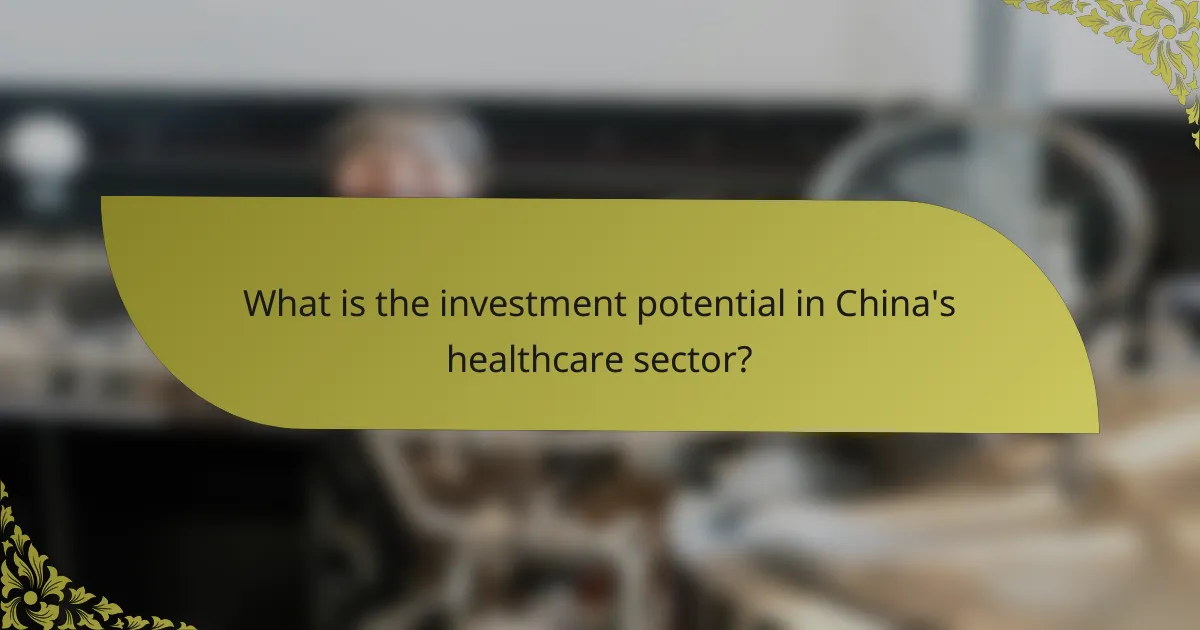The healthcare sector in China presents significant opportunities driven by the expansion of telemedicine services, government support for digital health initiatives, and a rising demand for elderly care services due to an aging population projected to reach 487 million by 2050. The biotechnology and pharmaceutical industries are rapidly growing, with increased investment in innovative drug development and healthcare infrastructure projects. The sector is anticipated to reach a market size of approximately $1 trillion by 2025, supported by healthcare reforms and favorable foreign investment policies. Understanding regulatory frameworks, such as the Medical Device Supervision and Administration Regulation (MDSAR) and National Medical Products Administration (NMPA) requirements, is essential for navigating market access and compliance in this dynamic environment.

What are the current opportunities in the healthcare sector in China?
The current opportunities in the healthcare sector in China include the expansion of telemedicine services. The Chinese government supports digital health initiatives to improve access to care. There is also a growing demand for elderly care services due to an aging population. According to the National Bureau of Statistics, the elderly population is expected to reach 487 million by 2050. Additionally, biotechnology and pharmaceutical sectors are experiencing rapid growth. Investment in innovative drug development is on the rise, driven by a strong emphasis on research and development. Healthcare infrastructure projects are also being prioritized, with significant funding allocated for hospital expansions and upgrades. These factors collectively create a favorable environment for investment and growth in China’s healthcare sector.
How is the healthcare market evolving in China?
The healthcare market in China is rapidly evolving due to increased public spending and aging demographics. Government initiatives aim to expand healthcare access and improve quality. The market is shifting towards digital health solutions, including telemedicine and health apps. Investment in biotechnology and pharmaceuticals is also growing significantly. In 2022, China’s healthcare expenditure reached approximately $1 trillion. The rise of private healthcare providers is enhancing competition and service quality. Regulatory reforms are streamlining approvals for new drugs and medical devices. These trends indicate a dynamic transformation in China’s healthcare landscape.
What are the key drivers of growth in the Chinese healthcare sector?
The key drivers of growth in the Chinese healthcare sector include an aging population, increasing chronic diseases, and government reforms. The population aged 65 and older is projected to reach 487 million by 2050. This demographic shift increases demand for healthcare services and products. Chronic diseases, such as diabetes and heart disease, are rising, affecting over 300 million people in China. These conditions require ongoing medical care and management, further fueling sector growth. Additionally, the Chinese government has implemented reforms to expand health insurance coverage. Initiatives like the Healthy China 2030 plan aim to improve healthcare accessibility and quality. Investment in healthcare technology and innovation is also on the rise, with the sector attracting significant foreign and domestic investment. These factors collectively contribute to robust growth in China’s healthcare sector.
What role does technology play in the evolution of healthcare in China?
Technology plays a crucial role in the evolution of healthcare in China. It enhances patient care through telemedicine and digital health records. Telemedicine allows remote consultations, increasing access to healthcare services. Digital health records improve data management and patient tracking. The integration of artificial intelligence aids in diagnostics and treatment planning. Mobile health applications empower patients to manage their health proactively. Moreover, technology streamlines administrative processes, reducing costs and improving efficiency. According to a report by the China National Health Commission, telemedicine usage increased significantly during the COVID-19 pandemic, illustrating its growing importance. Overall, technological advancements are transforming healthcare delivery and accessibility in China.
What are the major challenges facing the healthcare sector in China?
The major challenges facing the healthcare sector in China include an aging population, unequal access to healthcare, and rising healthcare costs. The aging population is expected to reach 400 million by 2040, increasing demand for medical services. Unequal access to healthcare results in significant disparities between urban and rural areas. Approximately 90% of healthcare resources are concentrated in urban regions, leaving rural populations underserved. Rising healthcare costs strain both government budgets and individual households. In 2020, out-of-pocket expenses accounted for 28% of total healthcare spending in China. Additionally, the healthcare system faces issues with quality and efficiency, leading to patient dissatisfaction. These challenges necessitate urgent reforms to ensure sustainable healthcare delivery.
How do regulatory hurdles impact healthcare providers in China?
Regulatory hurdles significantly impact healthcare providers in China by creating barriers to entry and operational challenges. These hurdles include stringent licensing requirements and complex approval processes for new medical technologies. As a result, healthcare providers often face delays in bringing services and products to market. Compliance with regulations can also increase operational costs. For example, a 2021 report indicated that over 60% of healthcare providers cited regulatory compliance as a major challenge. Furthermore, these hurdles can limit the availability of innovative treatments, affecting patient care. Overall, regulatory challenges can hinder the growth and efficiency of healthcare providers in China.
What are the financial challenges faced by healthcare startups in China?
Healthcare startups in China face several financial challenges. Limited access to funding is a primary issue. Traditional banks often hesitate to lend to startups due to perceived risks. Venture capital investment can be competitive and not guaranteed. Regulatory hurdles also increase costs, making it harder to secure financing. High operational costs, including technology and talent acquisition, strain budgets. Furthermore, the rapidly changing market demands agility, which can be financially burdensome. In 2021, only 25% of healthcare startups reported securing sufficient funding to meet their needs. This statistic underscores the financial difficulties within the sector.

What is the investment potential in China’s healthcare sector?
The investment potential in China’s healthcare sector is significant. The sector is projected to reach a market size of approximately $1 trillion by 2025. This growth is driven by an aging population and increasing demand for healthcare services. In 2021, the healthcare expenditure in China was around $1.4 trillion, indicating robust growth. The Chinese government supports healthcare reforms, which enhances investment opportunities. Additionally, foreign investment in healthcare has been encouraged through favorable policies. The rise of telemedicine and digital health solutions further expands investment avenues. Overall, China’s healthcare sector presents a dynamic environment for investors seeking growth.
How attractive is China for foreign investors in healthcare?
China is highly attractive for foreign investors in healthcare. The country has a rapidly growing healthcare market, projected to reach $1 trillion by 2025. This growth is driven by an aging population and increasing healthcare demands. Additionally, the Chinese government supports foreign investment through favorable policies. For instance, the “Healthy China 2030” initiative promotes innovation and collaboration. Foreign companies can benefit from partnerships with local firms. The market is also becoming more open, with reduced restrictions on foreign ownership. These factors make China a promising destination for healthcare investment.
What are the trends in foreign direct investment in Chinese healthcare?
Foreign direct investment in Chinese healthcare is increasing steadily. In recent years, foreign investors have shown growing interest in China’s healthcare sector. This trend is driven by China’s aging population and rising demand for healthcare services. In 2021, foreign investments in China’s healthcare reached approximately $10 billion. The Chinese government has implemented policies to attract foreign capital. These policies include easing restrictions on foreign ownership in healthcare facilities. Additionally, partnerships between foreign firms and local companies are becoming more common. This collaboration aims to enhance technology transfer and improve service quality. The overall trend indicates a favorable environment for foreign investment in Chinese healthcare.
What sectors within healthcare are seeing the most investment?
Biotechnology, telemedicine, and digital health are sectors within healthcare seeing the most investment. Biotechnology is attracting significant funding due to advancements in drug development and personalized medicine. Telemedicine has gained traction, especially post-pandemic, with increased demand for remote healthcare services. Digital health technologies, including wearable devices and health apps, are also experiencing rapid investment growth. According to a report by Rock Health, U.S. digital health funding reached $14.7 billion in 2020, highlighting the sector’s robust investment potential. These trends indicate a shift towards innovative healthcare solutions that enhance patient care and accessibility.
What are the risks associated with investing in China’s healthcare sector?
Investing in China’s healthcare sector carries several risks. Regulatory changes can impact investment stability. The Chinese government frequently revises healthcare policies. These changes can affect reimbursement rates and market access. Additionally, market competition is intense. Numerous domestic and international players are vying for market share. Intellectual property protection is also a concern. Companies may face challenges in safeguarding their innovations. Furthermore, economic fluctuations can influence healthcare spending. A slowdown in China’s economy could reduce investment returns. Lastly, geopolitical tensions may create uncertainties. These tensions can affect foreign investments and partnerships.
How do political factors influence investment decisions in healthcare?
Political factors significantly influence investment decisions in healthcare. Government policies, regulations, and political stability shape the investment landscape. For instance, favorable healthcare reforms can attract foreign investment. Conversely, stringent regulations may deter potential investors. Additionally, political stability ensures a predictable environment for long-term investments. In China, the government’s commitment to healthcare modernization has spurred investment opportunities. According to McKinsey, China’s healthcare spending is expected to reach $1 trillion by 2025, driven by supportive policies. Thus, the political climate directly impacts investor confidence and strategic decisions in the healthcare sector.
What are the market entry challenges for foreign investors?
Market entry challenges for foreign investors include regulatory hurdles, cultural differences, and market competition. Foreign investors often face complex regulations that vary by region in China. Compliance with local laws and standards can be time-consuming and costly. Cultural differences also pose challenges in understanding consumer behavior and preferences. Additionally, the healthcare sector is highly competitive with established local players. Foreign investors must navigate these challenges to successfully enter the market. According to the China-United States Trade and Economic Cooperation Working Group, regulatory compliance remains a significant barrier for foreign businesses.

What regulatory insights are crucial for navigating the healthcare sector in China?
Regulatory insights crucial for navigating the healthcare sector in China include understanding the Medical Device Supervision and Administration Regulation (MDSAR). This regulation outlines the processes for the registration and approval of medical devices. Companies must comply with the National Medical Products Administration (NMPA) requirements. The NMPA oversees drug and medical device approvals, ensuring safety and efficacy. Knowledge of the latest amendments to these regulations is essential for compliance. Additionally, understanding the pricing and reimbursement policies is critical. These policies affect market access and profitability for healthcare products. Familiarity with local laws and industry standards can prevent legal issues. Engaging with local partners can facilitate navigating these complex regulations.
What are the key regulations impacting the healthcare industry in China?
The key regulations impacting the healthcare industry in China include the Healthcare Security Law and the Drug Administration Law. The Healthcare Security Law, enacted in 2016, aims to provide universal health coverage and improve access to medical services. It mandates the establishment of a multi-tiered health insurance system. The Drug Administration Law, revised in 2019, focuses on the approval process for new drugs and emphasizes drug safety and efficacy. This law shortens the review timeline for innovative drugs. Additionally, the Medical Device Supervision and Administration Regulations regulate the production and sale of medical devices. These regulations are essential for ensuring compliance and safety in healthcare practices.
How do licensing requirements affect healthcare providers?
Licensing requirements significantly impact healthcare providers by determining their ability to practice legally. These regulations ensure that providers meet specific educational and professional standards. In China, healthcare providers must obtain licenses issued by government authorities. This process includes passing examinations and fulfilling continuing education requirements. Compliance with licensing requirements affects providers’ operational capabilities and market access. Non-compliance can result in penalties, including fines or suspension of practice. Moreover, licensing can influence the quality of care delivered to patients, as it mandates adherence to established medical standards. Ultimately, licensing requirements shape the overall structure and functioning of the healthcare system.
What changes to regulations are anticipated in the near future?
Anticipated changes to regulations in the healthcare sector in China include stricter compliance measures for pharmaceutical companies. The government aims to enhance drug safety and efficacy standards. Additionally, there may be increased transparency requirements for clinical trial data. These changes are expected to foster greater public trust in healthcare products. The adjustments align with global regulatory trends focusing on patient safety. Reports indicate that these modifications will be implemented within the next few years. This regulatory shift reflects China’s commitment to improving healthcare quality.
How can companies comply with China’s healthcare regulations?
Companies can comply with China’s healthcare regulations by understanding the regulatory framework. This framework includes laws such as the Drug Administration Law and the Medical Device Supervision and Administration Regulation. Companies should ensure their products meet quality standards set by the National Medical Products Administration (NMPA). They must also obtain necessary licenses and permits before market entry. Regular audits and compliance checks help maintain adherence to these regulations. Engaging with local legal experts can provide insights into specific requirements. Training staff on compliance procedures is also crucial. Companies should stay updated on regulatory changes to avoid penalties.
What are the best practices for ensuring regulatory compliance?
The best practices for ensuring regulatory compliance include establishing a compliance program, conducting regular audits, and providing employee training. A compliance program outlines policies and procedures to meet regulatory requirements. Regular audits help identify gaps in compliance and areas for improvement. Employee training ensures that staff understand regulations and their responsibilities. Additionally, maintaining clear documentation supports compliance efforts. Engaging with legal and regulatory experts can provide guidance on complex regulations. Staying updated on changes in laws and regulations is crucial for ongoing compliance. These practices collectively help organizations navigate the regulatory landscape effectively.
How can companies stay updated on regulatory changes?
Companies can stay updated on regulatory changes by subscribing to industry newsletters and regulatory bodies’ alerts. These resources provide timely information on changes that affect the healthcare sector. Engaging with legal consultants is also essential for expert guidance on compliance. Attending industry conferences and seminars offers insights from experts on upcoming regulations. Networking with industry peers can facilitate information sharing about regulatory developments. Utilizing technology, such as compliance management software, helps track changes efficiently. Regularly reviewing government websites ensures access to official updates on regulations. Monitoring social media channels of relevant agencies can provide real-time information. These strategies help companies navigate the evolving regulatory landscape in China’s healthcare sector.
What practical steps can stakeholders take to succeed in China’s healthcare sector?
Stakeholders can succeed in China’s healthcare sector by focusing on strategic partnerships, understanding regulatory landscapes, and investing in technology. Forming alliances with local firms can enhance market entry and build trust. Familiarity with China’s healthcare regulations is crucial for compliance and operational success. Investment in digital health solutions, such as telemedicine and electronic health records, is growing rapidly. According to a report by McKinsey, digital health investments in China reached $5 billion in 2021. Engaging in continuous market research helps stakeholders stay informed about emerging trends and consumer needs. Additionally, prioritizing patient-centered care can improve service delivery and outcomes.
The main entity of this article is the healthcare sector in China. The article provides an in-depth analysis of current opportunities within this sector, highlighting the expansion of telemedicine, the growing demand for elderly care, and advancements in biotechnology and pharmaceuticals. It also examines the evolving market landscape driven by increased public spending, government reforms, and technological integration, while addressing significant challenges such as unequal access to care and regulatory hurdles. Furthermore, the article discusses the investment potential for foreign investors, key regulations impacting the industry, and practical steps stakeholders can take to navigate this dynamic environment successfully.



